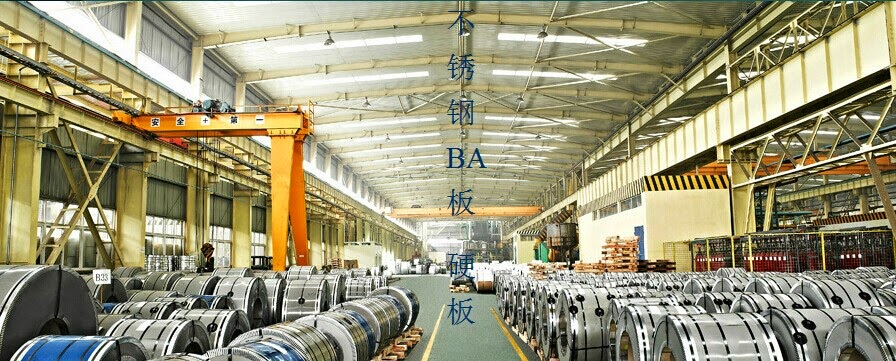Stainless steel plate manufacturing method are two hot and cold, including sheets and 4.5-35 mm thickness of 0.5-4 mm thick by organizational characteristics of steel is divided into five categories: austenitic, austenitic - ferritic, ferritic, martensitic, precipitation hardening. Requirements can withstand acid, 410 stainless steel plate acid - ferric sulfate, nitrate, nitric acid - hydrofluoric acid, sulfuric acid - stainless steel 409 sulfate, phosphoric acid, formic acid, acetic acid and other corrosive, widely used in chemical, food, pharmaceutical, paper, oil, nuclear, etc. industry and construction, kitchen utensils, cutlery, vehicles, household appliances all kinds of spare parts.
Magnetic stainless steel sheets, the major material that Qiyi are supplying both domestic and aboard, which include stainless steel 430, stainless steel 409, stainless steel 410, etc. playing a very important role in our precision steel supplying chain , we offer magnetic stainless steel in coils , sheets , strip , plates and so forth.
2014年6月25日星期三
Premise magnetic stainless steel performance to meet the requirements of
In order to ensure the yield strength of various types of stainless steel, mechanical properties of tensile strength, elongation and hardness to meet the requirements, you must go through stainless steel 430, solution treatment, aging heat treatment prior to delivery of steel. Corrosion resistance of stainless steel depends primarily on its alloy composition (chromium, nickel, titanium, silicon, aluminum, etc.) and internal organizational structure, play a major role in the chromium. Chromium has a high chemical stability, steel coil stainless steel film formed on the surface of the metal with the outside world to isolate and protect steel from oxidation, increase the corrosion resistance of steel. After the destruction of the passive film, corrosion resistance decreased.
2014年6月23日星期一
Analysis of the performance characteristics of magnetic stainless steel plate
Corrosion resistance
Stainless steel with nickel-chromium alloy with an unstable 304 similar to resist corrosion. For a long time in the degree of chromium carbide heating temperature range may affect alloy 430 stainless steel sheet and 347 in the harsh corrosive medium. Mainly used in high temperature applications, high-temperature applications require materials with strong anti-allergy activity in order to prevent stainless steel coils between grains lower temperatures.
High temperature oxidation resistance
Stainless steel has high temperature oxidation resistance, however, the oxidation rate will be affected by exposure to environmental and product form factors such as inherent.
Stainless steel with nickel-chromium alloy with an unstable 304 similar to resist corrosion. For a long time in the degree of chromium carbide heating temperature range may affect alloy 430 stainless steel sheet and 347 in the harsh corrosive medium. Mainly used in high temperature applications, high-temperature applications require materials with strong anti-allergy activity in order to prevent stainless steel coils between grains lower temperatures.
High temperature oxidation resistance
Stainless steel has high temperature oxidation resistance, however, the oxidation rate will be affected by exposure to environmental and product form factors such as inherent.
Technical Standard magnetic stainless steel plate
Corrosion resistance of stainless steel plate, the bending workability and toughness of welded portion, and the punching workability of the welded portions of high-strength steel sheet excellent in its manufacturing method. Specifically included are the C: 0.02% or less, N: 409
stainless steel or less, Cr: more than 11% but less than 17%, the content of the appropriate Si, Mn, P, S, Al, Ni, and satisfies 12 ≤ Cr Mo 1.5Si ≤ 17,1 ≤ Ni 30 (CN) 0.5 (Mn Cu) ≤ 4, Cr 0.5 (Ni Cu) 3.3Mo ≥ 16.0,0.006 ≤ CN ≤ 0.030 stainless steel plate heated to 850 ~ 1250 ℃, and then to 1 Stainless steel factory the cooling rate of the above heat treatment. This can be a tissue containing mroe than 12% volume fraction of martensite, 730MPa or more high strength, corrosion resistance and bending workability, excellent HAZ toughness, high strength stainless steel. Recycling containing Mo, B, etc., can significantly improve the performance of welded parts stamping.
2014年6月15日星期日
magnetic stainless steel sheets of non-magnetic or weakly magnetic introduction
Austenite is weak magnetic or non-magnetic, while ferrite and martensite is magnetic, due to improper segregation smelting or heat, or may cause a small amount of martensite 304 austenitic ferritic 430 stainless steel suppliers occurs organization, so 304 will appear weak magnetic. In addition, 304 stainless steel after cold working, the organizational structure will be transformed to martensite, the greater the cold deformation, stainless steel magnetic transformation, the more will be the stronger magnetic. Want to completely eliminate 304magnetic stainless steel sheets, you can restore stability austenite at high temperature solution treatment, thus eliminating magnetic.
2014年6月8日星期日
introduction of magnetic stainless steel
Typically, 410 stainless steel plate stainless steel (represented in 304) is non-magnetic, but may have weak magnetism, and ferrite (mainly 430,409 L, 439, and 445NF etc.) and martensite (in 410 as the representative) are generally with magnetic.
magnetic stainless steel there are some kinds of Precision stainless steel(such as 304, etc.) are classified as "non-magnetic stainless steel" refers to its magnetic indicator just below a certain value, that is, more or less generally stainless steel with a certain magnetism.
2014年6月4日星期三
Magnetic magnetic stainless materials
Therefore, the magnetic material is arranged by the molecule determines whether the same rules and isotropic electron spin, we believe that the physical properties of stainless steel coils manufacturers, and corrosion resistance of the material can then be stainless steel 301 by the chemical composition of the material, and chemical materials properties, and regardless of whether there is a magnetic material. From magnetic stainless development perspective, instead of the 300 series 400 series can be described as a trend.
订阅:
博文 (Atom)





